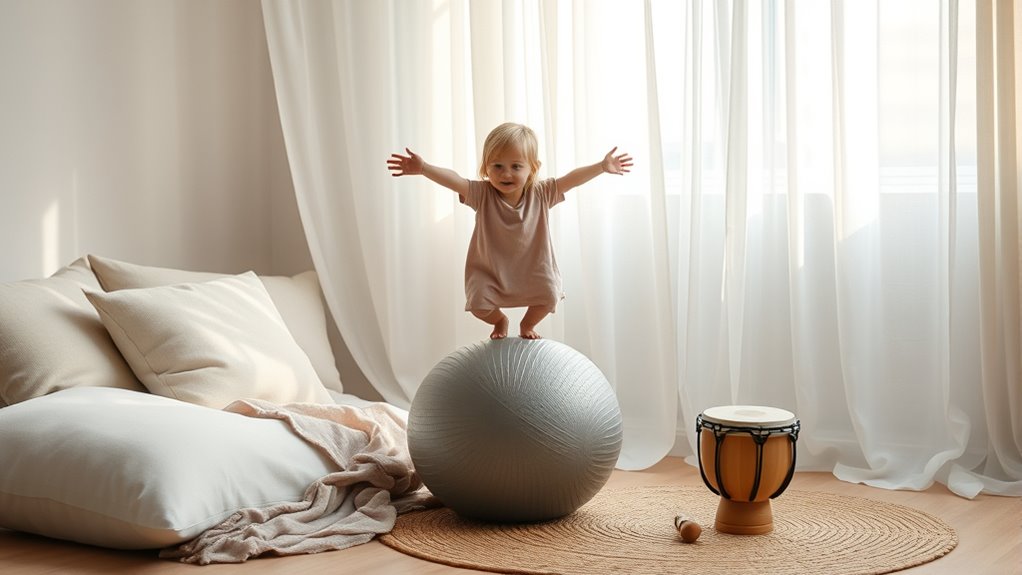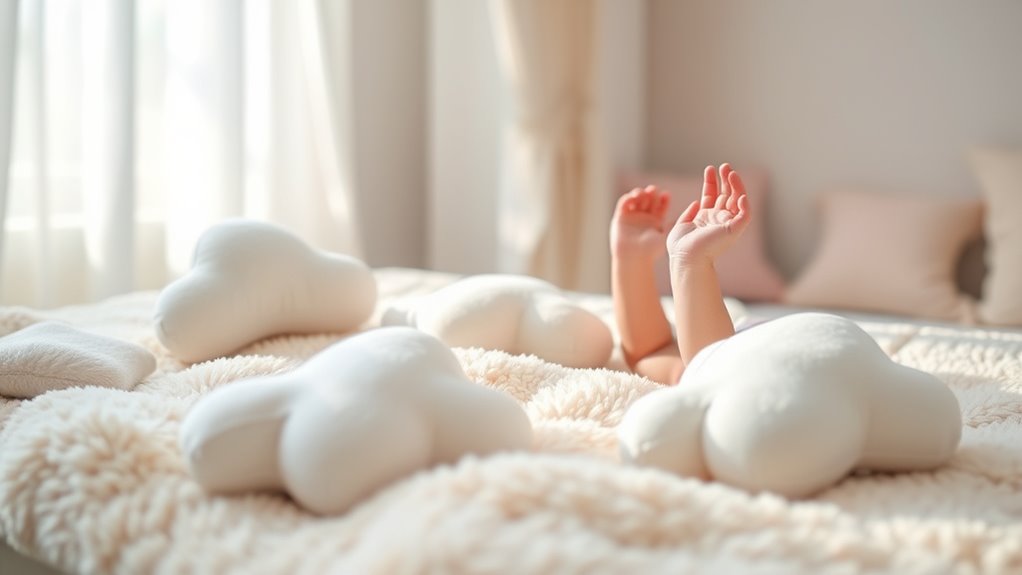For zero-pressure play ideas, focus on gentle touch and sound to soothe your baby. Softly massage their hands, feet, or back, and sing lullabies or whisper softly to create calming auditory cues. Use textured toys and soft lighting to encourage visual and tactile exploration without overstimulation. Incorporate gentle rocking or swaying to promote relaxation. These calming activities help build security and curiosity—continue exploring more ways to support your baby’s soothing experiences.
Key Takeaways
- Engage in gentle tactile exploration by softly massaging baby’s hands, feet, or back with varied textures.
- Use soothing sounds like lullabies or whispering to calm and stimulate auditory senses gently.
- Incorporate soft, textured toys with crinkly or plush surfaces for safe, pressure-free tactile play.
- Create a calming environment with warm, diffused lighting and soft movement to promote relaxation.
- Sway or gently rock in rhythm with calming music, maintaining smooth, unhurried motions for comfort.
Gentle Sensory Exploration Through Touch and Sound

For young babies, gentle sensory exploration through touch and sound offers a safe and engaging way to stimulate their developing senses. You can start by softly massaging your baby’s hands, feet, or back with gentle strokes, helping them become familiar with different textures. Whispering or singing lullabies provides calming auditory input, encouraging listening skills and emotional bonding. Introducing simple toys with varied textures, such as soft fabric or crinkly materials, allows your baby to explore through touch. Keep sounds gentle and soothing to avoid overwhelming them. As your baby responds to these sensations, you’ll foster their curiosity and sensory development. Remember, the key is gentle, consistent stimulation that makes your baby feel secure while discovering new textures and sounds. Aura colors can sometimes reflect a baby’s emotional or sensory states, offering additional insight into their well-being.
Cozy Visual Stimulation and Soft Light Play

Soft, gentle lighting naturally captures your baby’s attention and supports their visual development. Using warm, diffused lights creates a calming environment that helps your baby focus without overwhelming their sensitive eyes. You can hang a soft, fabric-covered lamp or place a gentle glow nightlight nearby to provide consistent, comforting illumination. Avoid harsh or flashing lights, which can cause overstimulation. As your baby gazes at the soft glow, their developing eyesight benefits from the contrast and subtle movement. Keep the lighting at a low level to encourage relaxed visual tracking. Incorporating gentle light play provides a soothing sensory experience that promotes focus and curiosity, helping your baby explore their environment comfortably. This cozy visual stimulation sets a peaceful tone for your time together. Understanding AI safety emphasizes the importance of creating a safe and non-overstimulating environment for young children.
Creating Calm Moments With Soothing Rhythms and Gentle Movements

Gently introducing soothing rhythms and slow, deliberate movements can help your baby feel safe and relaxed. You might sway softly side to side or gently rock them in your arms, matching your movements to calming music or gentle sounds. Using a soft voice or singing lullabies can enhance the sense of security. Keep your motions smooth and unhurried, allowing your baby to settle into the rhythm. This gentle motion not only calms your baby but also fosters a connection between you both. Pay attention to their cues—if they seem soothed, continue; if they become restless, pause and try again later. Creating these calm moments helps your little one feel safe, promoting peaceful sleep and a sense of comfort in their environment. Incorporating mindfulness into your routine can further enhance the calming effect and deepen your bond.
Frequently Asked Questions
How Can I Adapt Zero-Pressure Play for Different Age Groups?
To adapt zero-pressure play for different age groups, focus on their developmental needs and interests. For younger kids, keep activities simple and sensory-rich, like soft toys or water play. Older children benefit from more creative, open-ended tasks, like art or storytelling. Always observe their responses and adjust the level of challenge accordingly. By tuning into their cues, you’ll foster a relaxed environment that encourages exploration and joy for all ages.
Are There Safety Concerns With Specific Sensory Toys for Infants?
Think of sensory toys as tiny explorers on a mission—you want them to discover securely. For infants, avoid toys with small parts that could be swallowed or choked on. Steer clear of toys with sharp edges or toxic materials. Always check for safety labels and ensure toys are age-appropriate. Like a guardian angel, your vigilance helps your little explorer discover the world safely and joyfully.
What Are Some Quiet Activities for Highly Sensitive Children?
You’re asking about quiet activities for highly sensitive children, which helps them feel secure and calm. Consider activities like reading gentle stories, doing sensory bins with soft textures, or practicing mindfulness with simple breathing exercises. You can also create cozy spaces for quiet time or let them explore calming art projects. These activities allow your child to relax without overwhelming their senses, fostering comfort and confidence in a peaceful environment.
How Do I Incorporate Zero-Pressure Play Into Daily Routines?
To incorporate zero-pressure play into your daily routine, start simply by setting aside special, stress-free moments. Encourage your child to explore and enjoy activities at their own pace—no rules, no expectations. Create calming, consistent cues like quiet corners or soft music to foster comfort. By blending gentle guidance with open-ended opportunities, you’ll help your child feel safe, supported, and spontaneous in their play, making everyday routines more relaxed and enjoyable.
Can Zero-Pressure Play Support Children With Sensory Processing Disorders?
You might wonder if zero-pressure play helps children with sensory processing disorders. It definitely can, as it provides calming, gentle sensory input without overwhelming them. By creating a safe space where kids can explore at their own pace, you support their regulation and comfort. This approach encourages sensory integration, reduces anxiety, and builds trust, helping children feel more secure and confident in managing their sensory experiences.
Conclusion
By embracing gentle, zero-pressure play, you help your baby discover the world at their own pace. Research suggests that such calm, sensory-rich experiences support healthy development and strengthen your bond. When you focus on soothing touch, soft lights, and gentle rhythms, you create a safe space for your little one to explore without overwhelm. Trust in these simple moments—they’re foundational for your baby’s growth and your connection.









